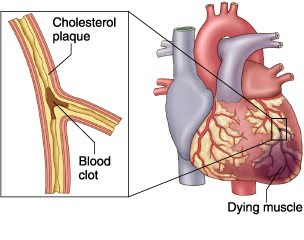12 Nursing Diagnosis for Myocardial Infarction
Chest pain or pressure is the most common symptom of a heart attack, Myocardial infarction (MI) or heart attack victims may experience a variety of symptoms including:
- Pain, fullness, and/or squeezing sensation of the chest
- Jaw pain, toothache, headache
- Shortness of breath
- Nausea, vomiting, and/or general epigastric (upper middle abdomen) discomfort
- Sweating
- Heartburn and/or indigestion
- Arm pain (more commonly the left arm, but may be either arm)
- Upper back pain
- General malaise (vague feeling of illness)
- No symptoms (Approximately one quarter of all heart attacks are silent, without chest pain or new symptoms. Silent heart attacks are especially common among patients with diabetes mellitus.)
Nursing Care Plan for Myocardial Infarction
12 Nursing Diagnosis for Myocardial Infarction
1. Decreased Cardiac Output
related to:
changes in the frequency of heart rhythm.
2. Impaired Tissue Perfusion
related to:
decrease in cardiac output.
3. Ineffective Airway Clearance
related to:
accumulation of secretions.
4. Ineffective Breathing Pattern
related to:
lung development is not optimal.
5. Impaired Gas Exchange
related to:
pulmonary edema.
6. Acute Pain
relate to:
increase in lactic acid.
7. Fluid Volume Excess
related to:
retention of sodium and water.
8. Imbalanced Nutrition, Less Than Body Requirements
related to:
Inadequate intake.
9. Activity Intolerance
relate to:
imbalance between myocardial oxygen supply and needs.
10. Self-Care Deficit
related to:
physical weakness.
11. Anxiety
related to:
ncaman death.
12. Knowledge Deficit
related to:
lack of information.
ads

5 komentar:
The information that you provided was thorough and helpful. I will have to share your article with others.telemedicina
Please continue to write more because it’s unusual that someone has something interesting to say about this.
Will be waiting for more! I have some relevant information you can review below.
Rejuvalash
buy Rejuvalash
Rejuvalash review
This was a very informative post. Thank you.
Best Factor
Thanks for the information and links you shared this is so should be a useful and quite informative!
preparation semi marathon
Thanks for information.....